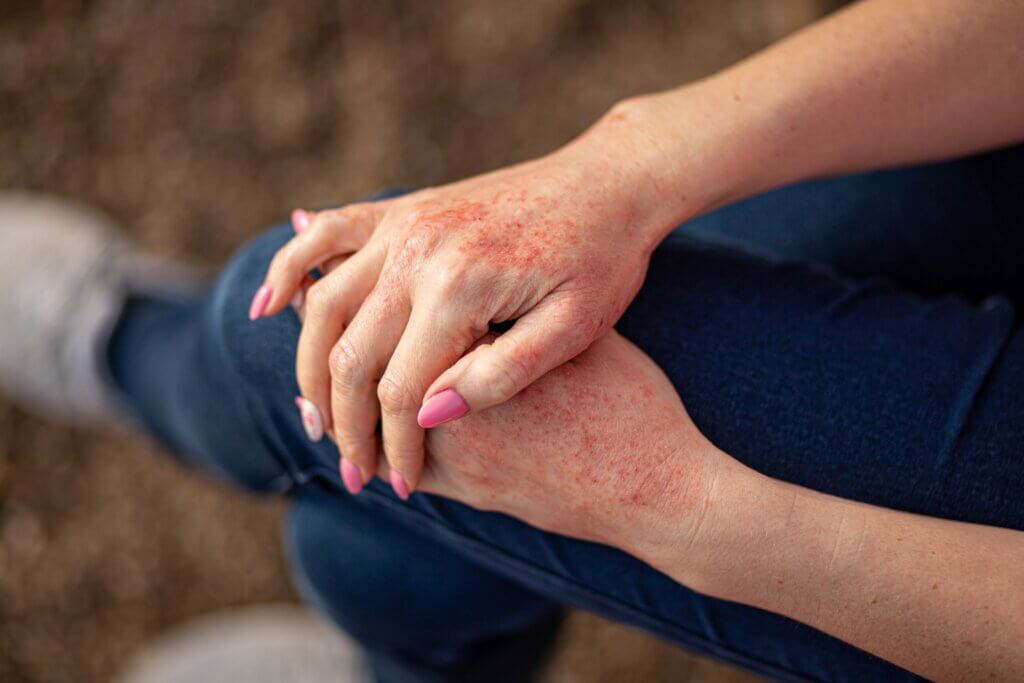The Effects of Smoking on the Skin

Despite the related health complications, smoking continues to be highly prevalent in society. Very little is said about the effects of smoking on the skin, partly because the focus has been on other types of associated problems. In the following article, we’ll review what scientists know about it and what the most frequent skin complications among smokers are.
7 effects of smoking on the skin
In general, smokers who’ve established the habit show distinctive superficial characteristics. Discolored nails, pigmentation in the oral area, pale-colored skin, and dry hair are some of them. We’ll analyze 7 effects of smoking on the skin that often go unnoticed among the population.
1. Premature aging of the skin

Perhaps one of the most notorious effects of smoking on the skin is premature aging of the skin. In fact, the term smoker’s face refers to the typical features on the face due to long-term tobacco intake. These include, for example, prominent wrinkles, sharply defined bone contours, and a gray complexion.
Premature skin aging from smoking is proportional to the number of cigarettes smoked per day and the total number of packs per year. According to researchers, those who smoke 40 or more packs a year develop this side effect up to 4 times more than non-smokers.
2. Pigmentation defects
As indicated by specialists, smoking is a risk factor for skin pigmentation. Although the process isn’t well understood, it’s known to stimulate melanin-producing cells, especially on the face. As a consequence, darker colored spots appear and the skin becomes thicker.
In addition to this, holding cigarettes between your fingers can encourage them to turn yellow. This is a consequence of the toxins that they contain.
Tobacco stains on the fingers have been associated with greater health complications. In part, it’s because they’re a consequence of regular and excessive intake, which is related to greater adverse effects.
3. The increased risk of developing hidradenitis suppurativa
Smoking has been pointed out as the main risk factor for the development of hidradenitis suppurativa. Furthermore, tobacco intake is associated with a worse course of the condition and worse symptoms.
Hidradenitis suppurativa is a chronic skin disease that affects hair follicles. It’s characterized by deep nodules and abscesses, which are very painful and leave scarring.
At the same time, evidence suggests that smoking is a risk factor for the development of acne. In fact, the term smoker’s acne is sometimes used to refer to episodes triggered by the habit. Smoking can make pre-existing acne from other causes worse.
4. Alteration in the wound healing process
Have you ever wondered why doctors recommend quitting smoking before surgery? Among other things, it’s due to the risk of blood clots, heart and lung problems, and complications regarding wound healing.
Smoking affects cutaneous blood flow, which causes microcirculation disorders and tissue oxygenation.
Similarly, it can also affect the production of fibroblasts; a type of cell with a leading role in healing. Because wounds take longer to heal, people are at greater risk of infection and, in the specific case of surgery, wound dehiscence and necrosis.
Because of these associated complications, many surgeons hesitate to operate on patients who are reluctant to quit smoking.
5. An increased risk of developing psoriasis

Psoriasis is a chronic skin disease characterized by the presence of red, scaly patches. Experts consider smoking an independent risk factor for the disease in both women and men. Continuing the habit after diagnosis can worsen symptoms and associated complications.
6. Allergic contact dermatitis
Although it’s not something that’s often taken into consideration, different allergens are found in cigarette filters, paper, and in tobacco itself. The most common are licorice, menthol, cocoa, formaldehyde, and rosin.
As a result, and according to evidence, smoking can increase serum levels of total IgE. Allergic contact dermatitis and other types of dermatitis can arise as a consequence.
7. Increased risk of developing some types of cancer
Finally, another of the effects of smoking on the skin that we can’t fail to point out is the increased risk of developing some types of cancer. Affirming that smoking causes skin cancer is controversial, but a relationship has been found that should at least arouse suspicion.
Among others, it has been suggested to be a risk factor for squamous cell carcinoma and some studies and investigations have linked it to basal cell carcinoma and anogenital skin cancers, respectively.
Although all the cited studies refer to the effects of smoking on the skin in active smokers, many of these can also appear in passive smokers. All these complications must be taken into account and must be coupled with others that are already known in order to understand the risks of maintaining the habit.
Despite the related health complications, smoking continues to be highly prevalent in society. Very little is said about the effects of smoking on the skin, partly because the focus has been on other types of associated problems. In the following article, we’ll review what scientists know about it and what the most frequent skin complications among smokers are.
7 effects of smoking on the skin
In general, smokers who’ve established the habit show distinctive superficial characteristics. Discolored nails, pigmentation in the oral area, pale-colored skin, and dry hair are some of them. We’ll analyze 7 effects of smoking on the skin that often go unnoticed among the population.
1. Premature aging of the skin

Perhaps one of the most notorious effects of smoking on the skin is premature aging of the skin. In fact, the term smoker’s face refers to the typical features on the face due to long-term tobacco intake. These include, for example, prominent wrinkles, sharply defined bone contours, and a gray complexion.
Premature skin aging from smoking is proportional to the number of cigarettes smoked per day and the total number of packs per year. According to researchers, those who smoke 40 or more packs a year develop this side effect up to 4 times more than non-smokers.
2. Pigmentation defects
As indicated by specialists, smoking is a risk factor for skin pigmentation. Although the process isn’t well understood, it’s known to stimulate melanin-producing cells, especially on the face. As a consequence, darker colored spots appear and the skin becomes thicker.
In addition to this, holding cigarettes between your fingers can encourage them to turn yellow. This is a consequence of the toxins that they contain.
Tobacco stains on the fingers have been associated with greater health complications. In part, it’s because they’re a consequence of regular and excessive intake, which is related to greater adverse effects.
3. The increased risk of developing hidradenitis suppurativa
Smoking has been pointed out as the main risk factor for the development of hidradenitis suppurativa. Furthermore, tobacco intake is associated with a worse course of the condition and worse symptoms.
Hidradenitis suppurativa is a chronic skin disease that affects hair follicles. It’s characterized by deep nodules and abscesses, which are very painful and leave scarring.
At the same time, evidence suggests that smoking is a risk factor for the development of acne. In fact, the term smoker’s acne is sometimes used to refer to episodes triggered by the habit. Smoking can make pre-existing acne from other causes worse.
4. Alteration in the wound healing process
Have you ever wondered why doctors recommend quitting smoking before surgery? Among other things, it’s due to the risk of blood clots, heart and lung problems, and complications regarding wound healing.
Smoking affects cutaneous blood flow, which causes microcirculation disorders and tissue oxygenation.
Similarly, it can also affect the production of fibroblasts; a type of cell with a leading role in healing. Because wounds take longer to heal, people are at greater risk of infection and, in the specific case of surgery, wound dehiscence and necrosis.
Because of these associated complications, many surgeons hesitate to operate on patients who are reluctant to quit smoking.
5. An increased risk of developing psoriasis

Psoriasis is a chronic skin disease characterized by the presence of red, scaly patches. Experts consider smoking an independent risk factor for the disease in both women and men. Continuing the habit after diagnosis can worsen symptoms and associated complications.
6. Allergic contact dermatitis
Although it’s not something that’s often taken into consideration, different allergens are found in cigarette filters, paper, and in tobacco itself. The most common are licorice, menthol, cocoa, formaldehyde, and rosin.
As a result, and according to evidence, smoking can increase serum levels of total IgE. Allergic contact dermatitis and other types of dermatitis can arise as a consequence.
7. Increased risk of developing some types of cancer
Finally, another of the effects of smoking on the skin that we can’t fail to point out is the increased risk of developing some types of cancer. Affirming that smoking causes skin cancer is controversial, but a relationship has been found that should at least arouse suspicion.
Among others, it has been suggested to be a risk factor for squamous cell carcinoma and some studies and investigations have linked it to basal cell carcinoma and anogenital skin cancers, respectively.
Although all the cited studies refer to the effects of smoking on the skin in active smokers, many of these can also appear in passive smokers. All these complications must be taken into account and must be coupled with others that are already known in order to understand the risks of maintaining the habit.
- Aköz T, Akan M, Yildirim S. If you continue to smoke, we may have a problem: smoking’s effects on plastic surgery. Aesthetic Plast Surg. 2002 Nov-Dec;26(6):477-82.
- Bukvić Mokos Z, Miše J, Balić A, Marinović B. Understanding the Relationship Between Smoking and Hidradenitis Suppurativa. Acta Dermatovenerol Croat. 2020 Jul;28(1):9-13.
- Capitanio B, Sinagra JL, Ottaviani M, Bordignon V, Amantea A, Picardo M. Acne and smoking. Dermatoendocrinol. 2009 May;1(3):129-35.
- Goel N, Singh BP, Arora N, Kumar R. Effect of smoking on atopic predisposition and sensitisation to allergens. Indian J Chest Dis Allied Sci. 2008 Oct-Dec;50(4):329-33.
- Grant WB. Smoking overlooked as an important risk factor for squamous cell carcinoma. Arch Dermatol. 2004 Mar;140(3):362-3; author reply 363.
- John G, Louis C, Berner A, Genné D. Tobacco Stained Fingers and Its Association with Death and Hospital Admission: A Retrospective Cohort Study. PLoS One. 2015 Sep 16;10(9):e0138211.
- Kutlubay Z, Engin B, Zara T, Tüzün Y. Anogenital malignancies and premalignancies: facts and controversies. Clin Dermatol. 2013 Jul-Aug;31(4):362-373.
- Li W, Han J, Choi HK, Qureshi AA. Smoking and risk of incident psoriasis among women and men in the United States: a combined analysis. Am J Epidemiol. 2012 Mar 1;175(5):402-13.
- Lipa K, Zając N, Owczarek W, Ciechanowicz P, Szymaǹska E, Walecka I. Does smoking affect your skin? Postepy Dermatol Alergol. 2021 Jun;38(3):371-376.
- Nakamura M, Ueda Y, Hayashi M, Kato H, Furuhashi T, Morita A. Tobacco smoke-induced skin pigmentation is mediated by the aryl hydrocarbon receptor. Exp Dermatol. 2013 Aug;22(8):556-8.
- Raduan AP, Luiz RR, Manela-Azulay M. Association between smoking and cutaneous ageing in a Brazilian population. J Eur Acad Dermatol Venereol. 2008 Nov;22(11):1312-8.
- Smith JB, Randle HW. Giant basal cell carcinoma and cigarette smoking. Cutis. 2001 Jan;67(1):73-6.
Este texto se ofrece únicamente con propósitos informativos y no reemplaza la consulta con un profesional. Ante dudas, consulta a tu especialista.







